Pantheon Rome – A Look at the Roman Pantheon’s Architecture
The Pantheon in Italy is arguably the most influential building of all time. We see characteristics of the pantheon all over the world, despite it being the oldest and most well-preserved historical building. Engineers, architects, and artists alike are both inspired and baffled by the construction and beauty of the Pantheon. To this day, it is not entirely clear what the purpose of the original Pantheon building was. It is possible that the mystery surrounding the Pantheon is what draws thousands upon thousands of people to admire the building each year, without really understanding the history of the Pantheon.
The History of the Pantheon of Rome
Although it is such a popular building, not many people know the answer to the question “what is a pantheon?” Breaking up the Greek word “Pantheon” makes the meaning clearer and gives possible insight into what the purpose of the building was: pan means “all”, and theos means “gods”. The breakdown of the name thus makes it clear that the Pantheon served as a temple for the Greek gods, which answers the question of “what was the Pantheon used for?”
Whether the Pantheon was indeed used for this purpose, we will never know.
The Pantheon was built somewhere between 25 and 27 BC by Agrippa. Because of the name, it is speculated that the Pantheon was built as a temple to the twelve Greek Gods as well as to the living Sovran. Originally, it was believed that the building as it is today is the result of a reconstruction project by Hadrian that took place between 118 and 125 AD. The Pantheon is one of the sole Roman buildings that has remained perfectly intact throughout the centuries.
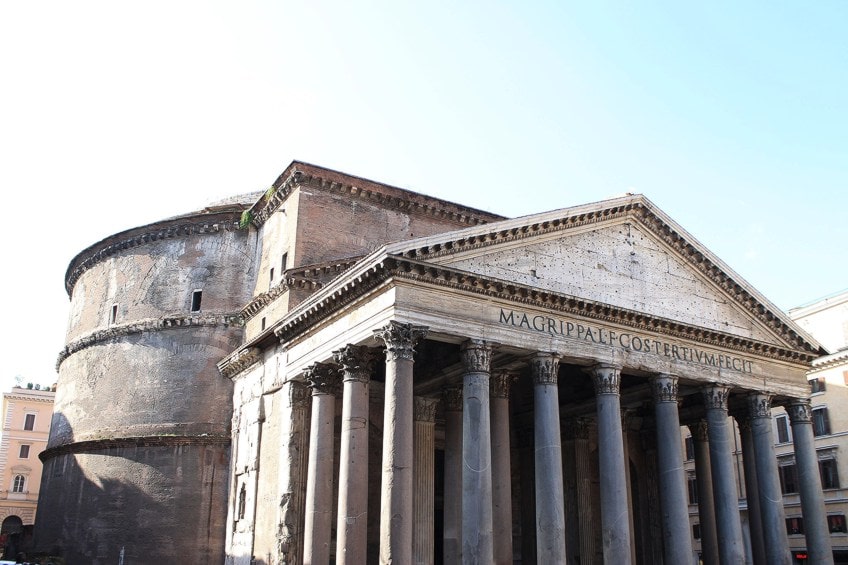
There used to be a lot of confusion surrounding the exact build date of the existing pantheon. The truth was discovered during the early 1900s when different bricks were studied throughout the entire building. The stamps of dates on these bricks, indicating when they were made and other markings on them which named the government officials at the time, made it clear that the Pantheon was built from 120 to 128 AD. This discovery also revealed the fact that the Pantheon was constructed during the rule of Hadrian, the Roman Emperor.
The above findings led to the belief that Hadrian was the architect of the newly erected Pantheon.
These beliefs are met when taking into consideration that Hadrian not only had a love for architecture but also for Roman and Greek culture. The merge of both Greek and Roman architectural themes in the Pantheon is thus a clear indication that Hadrian was the most likely architect of the building.
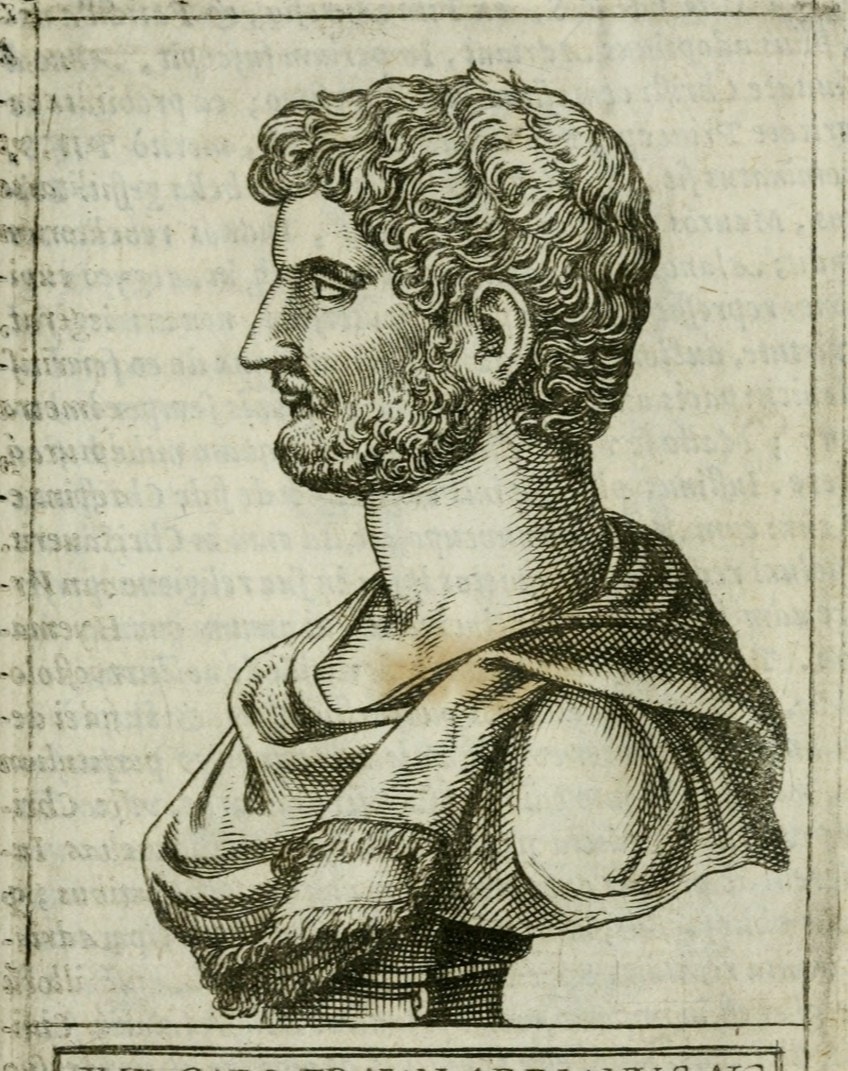
The year 117 A.D. was a time when the Roman Empire had power over all of what we know today as Europe, as well as some parts of Northern Africa and the Middle East. This was the year that Hadrian, who had an immense passion for art and architecture, became emperor.
Hadrian started a building campaign, which he pursued for the rest of his life up until he died in 138.
One of Hadrian’s buildings included Hadrian’s Wall, which was used as a type of defensive reinforcement. Hadrian’s wall, which measures 73 miles in length, exhibited the northwest boundary of the Roman Empire. In modern language, we know this part to stretch from the east to the coast across Northern England.
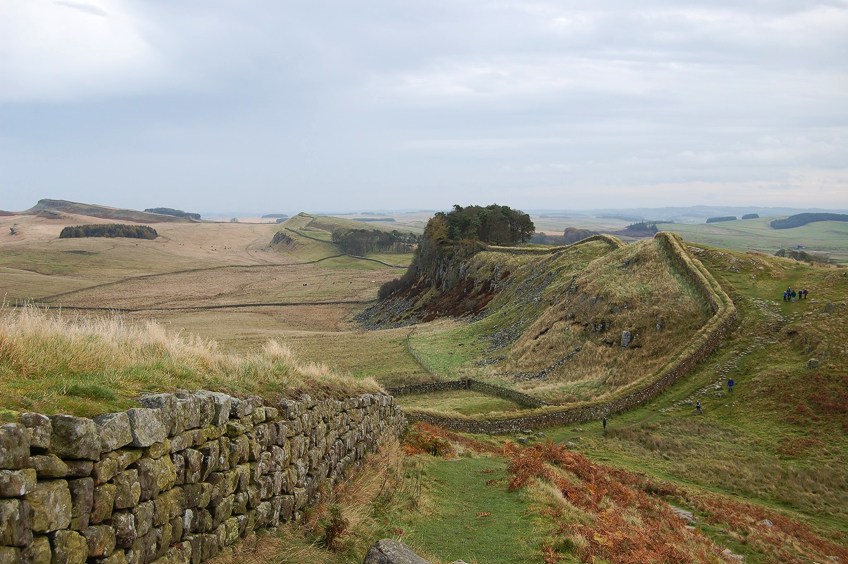
In 330, the Roman Empire’s capital was transferred by Emperor Constantine from Rome to Byzantium, which is now known as Istanbul, Turkey. After the transfer of power, the Pantheon fell into a lengthy period of neglect and disrepair. In 476, Odoacer, the German warrior dominated the west of the Roman Empire, where Rome was established. In 609, Pope Boniface IV received approval from Phocas, the Byzantine emperor at the time, to adapt the Pantheon into a Christian temple. The Pantheon was the first-ever Pagan temple to be converted to a Christian place of worship.
The conversion of the Pantheon to a Christian temple was essential to the survival of the building, to be able to make the necessary repairs and ongoing maintenance.
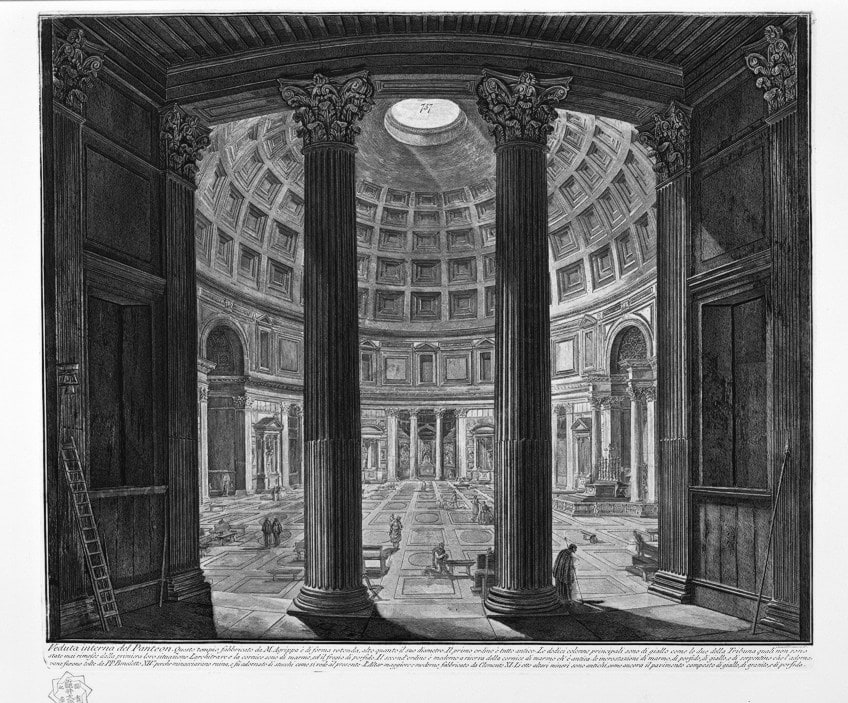
In 308, the remains of numerous martyrs were removed from various Christian catacombs and carefully relocated to the Pantheon at the request of Pope Boniface IV. After this relocation project, the temple was officially converted to the Christian religion and named Saint Maria ad Martyrs.
The Pantheon also contains the remains of Raphael, as the temple was such an inspiration to him, that he requested to be laid to rest there when the time came.
Another great artist, Michelangelo, even went as far as to proclaim that the Pantheon must have been built by the hands of angels, and not men. Along with these artists, various monarchs and architects are buried in the Pantheon:
| Monarch or Artist | Role | Date of Birth and Death |
| Baldassare Peruzzi | Architect | 1481-1536 |
| Raphael | Famous Artist | 1483-1520 |
| Taddeo Zuccaro | Frescoist | 1529-1566 |
| Flaminio Vacca | Sculptor | 1538-1605 |
| Annibale Carracci | Artist | 1560-1609 |
| King Vittorio Emanuele II | The first king of Italy since the sixth century | 1820-1878 |
| King Umberto I | The son of king Vittorio Emanuele II | 1844-1900 |
| Queen Margherita of Savoy | Wife of King Vittorio Emanuele II | 1851-1926 |
The answer to the question “when was the Pantheon built?” is usually a complicated one, because the current Pantheon is a rebuilt of what is considered to be the original Pantheon. The original Pantheon was located in the Campus Martius and built by Marcus Agrippa in 27 AD. The original building also faced south and was much more rectangular in form than the current Pantheon.
A fire completely destroyed the original building, after which Domitian had it restored in 80 AD. Believe it or not, the building caught fire again in 110 AD, after it was struck with lighting.
The Romans took the destruction of the building by fire, twice in a row, as a bad omen from the gods, who it was built for. For this reason, the remains of the Pantheon remained untouched for eight years until Hadrian became Emperor and started with his building program, which included the rebuilding of the Pantheon to how it stands up until this day.
About the Architect of the Pantheon in Rome
Hadrian, the architect who built the Pantheon, was born in 76 AD, in Italy, Spain to an upper-class family who originated from Rome. Hadrian’s father died when he was a mere nine years old, and his death had a great impact on his life, as this was the reason he went on to live with his cousin, Trajan, who at the time, was a general in the Roman army.
During his time living with his cousin and his wife, he became interested in architecture and art – two topics that continued to fascinate him throughout his life.
Trajan later became emperor, which meant that Hadrian received many titles while climbing ranks in the Roman empire. Before Trajan passed in 177 AD, he announced that Hadrian would be the man to succeed him as Rome’s emperor.
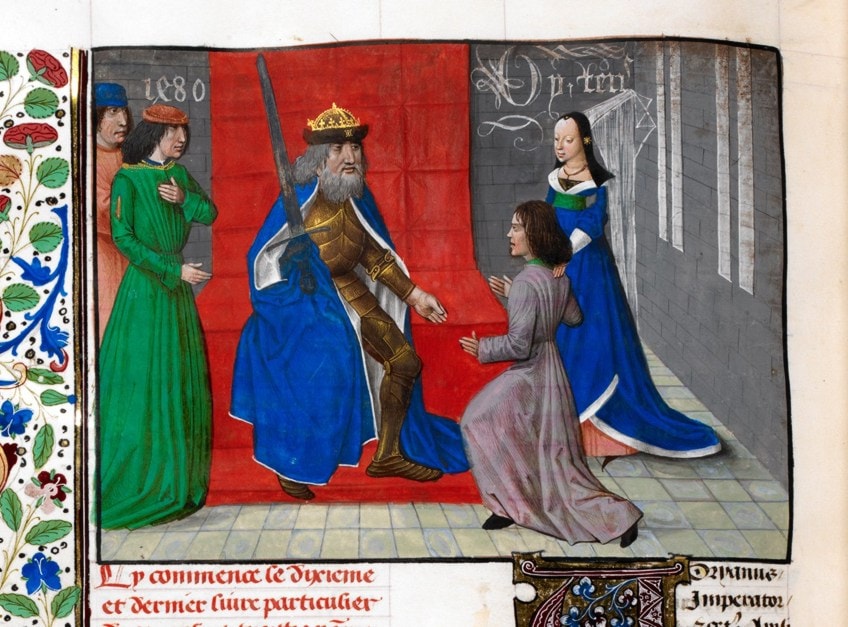
Emperor Hadrian was met with a lot of skepticism throughout his reign, as he was very vocal about not wanting to expand the Roman empire further, and that the borders of the empire should just be maintained. As a result, plans were made by other senators who thought themselves more worthy of the title emperor. Hadrian’s bodyguard ended up having these senators killed before they could put their plans into action.
The scandal surrounding Hadrian caused him to lose public favor, which is why he decided to start the building program in which the Pantheon was rebuilt. He wanted to give the people of Rome something to be proud of once again.
Hadrian was very fascinated with Greek culture and was of the opinion that Greek art and literature were far superior to that of the Romans. His obsession with Greek culture led to him being given the nickname “the Greekling”. The influence that Greek culture had on him can clearly be seen in the Pantheon architecture.
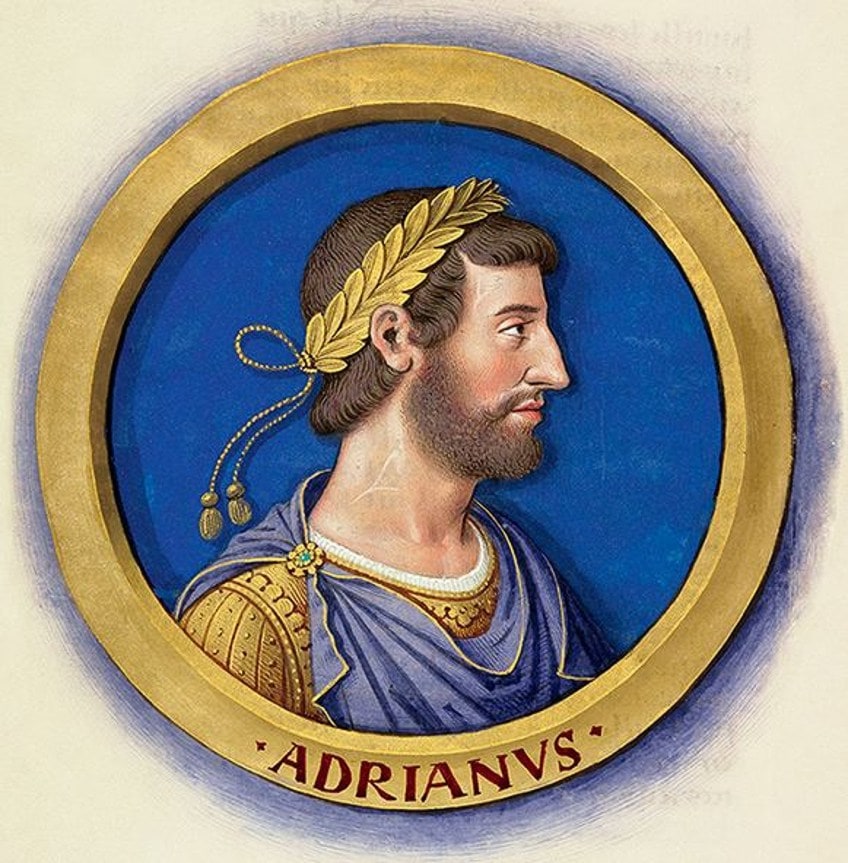
The Site
It is speculated the location in which the Pantheon of Rome was built, was not at all by chance. An ancient Roman legend suggests that the location of the Pantheon was the exact place where Romulus, the founder of Rome, died and where an eagle flew away with his lifeless body into the sky to be with the gods.
The Pantheon in Italy is surrounded by buildings 2000 years its junior and is the shortest of all these surrounding classical buildings.
It is important to note that historic Rome was much lower at sea level than it is at the moment, which made the original exterior experience of the Pantheon quite different from what it is today. Today, the Pantheon is level with the surrounding plaza, but originally it was elevated from the plaza with stairs leading upwards to the entrance. This also meant that the dome was not nearly as visible from the porch as it is today, as it would have been much higher up and difficult to see from below.
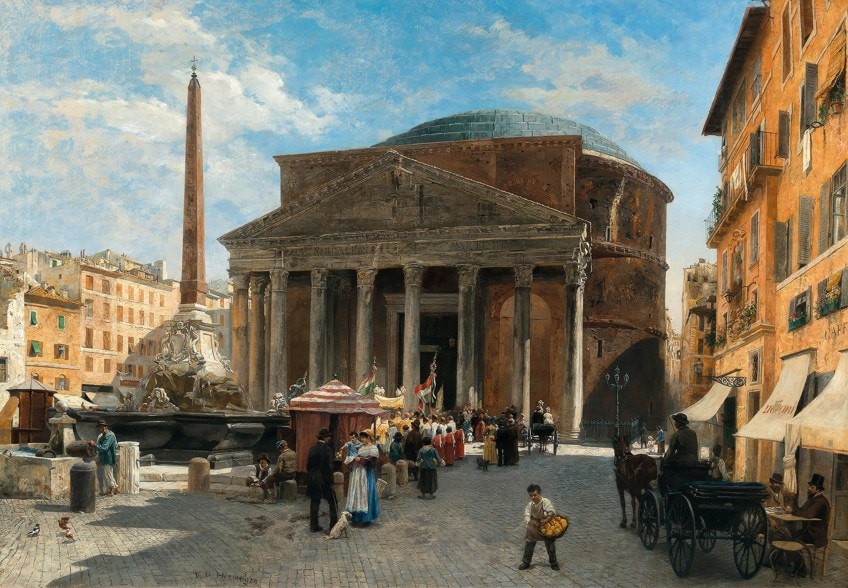
How the Pantheon of Rome Was Built
When considering how the Pantheon was built, it is important to ask the question “what was the Pantheon made of?”. The walls of the Pantheon were made entirely from Roman concrete. Unlike its modern counterpart, roman concrete was made from volcanic ash, known as Pozzolana, which was mixed with lime and fresh water.
Again, unlike modern concrete, it was laid out in thin layers of mortar, instead of being poured all at once.
The first step was to create a form for the concrete, which in those days was made from bricks. Coarse aggregate made from limestone pieces and broken tiles was layered down first, after which a combination of lime and pozzolana was troweled over it. About four feet of concrete was layered per day.

To ensure that the concrete had been set and dried evenly, the architect introduced recesses and niches into the walls to make the concrete walls a bit lighter to reduce the weight of the overall structure. These air voids created a pattern of arches in the walls.
The Pantheon of Rome is so significant because it is a mixture of two entirely different architectural styles: Ancient Roman architecture and Greek architecture.
The exterior of the Pantheon is very rectangular and pointy with a classic triangle on top, which is a typical feature of Greek architecture, whereas the interior of the Pantheon is rounded, which was typical for ancient Roman architecture.

The Portico
The covered entrance to the Pantheon consists of 16 classic Greek pillars. These pillars are massive in scale and made from Egyptian granite. The pillars are 40 feet tall and weigh about 50 tons each. Originally the heavily ornamented capitals or tops of the pillars were Corinthian pillars made from marble, but when the Pantheon was rebuilt, the pillars were carved entirely out of single pieces of stone, which now makes them monolithic columns.
It is interesting to note that there are very apparent holes in the top of these pillars.
These holes are evidence of iron clamps that were put in place on the pillars to hold metal decorations such as that of the roman empire eagle as well as the gods. These decorations melted during the destruction of the building when lightning struck.

The process of transporting these large pillars all the way from Egypt to Rome was an enormous task for a time when the engineering capabilities were not nearly as advanced as they are today. The pillars were hauled on carts from the quarries where they were carved out entirely, to the Nile River. The columns were then lifted onto large flatboats which floated down the river to Alexandria, where ships were waiting for them to be shipped by sea to Italy.
When arriving at the port of Ostia, the columns had to be dragged to the building site and finally erected by enormous groups of laborers.
All the columns are made from granite, which appears gray, except for the three columns on the east of the building (left of the front façade), which are clearly a warmer gray with more of a red tint. These three columns came from other Roman buildings and were fitted in the 17th century to replace the three columns that were severely damaged during the Middle Ages.

Above the columns, on the facade is a Latin inscription on the building that reads “Marcus Agrippa, son of Lucius, being consul for the third time, built this.” This inscription is in fact false, as Agrippa was in charge of the originally built pantheon, and not the current rebuilt one. The original Pantheon was destroyed by a fire and was replaced during the rule of Hadrian.
Hadrian left Agrippa’s name on the façade of the building as a humble gesture toward Agrippa.

The travertine triangular pediment of the Pantheon has many holes in the stone, which were used to display an enormous bronze eagle. The entrance doors that lead into the rotunda are large bronze doors that reach 24 feet high and are the earliest known doors of this specific type. The ceiling of the entrance facade is clearly made out of wooden slats but was originally constructed out of bronze tiling.
The bronze tiles were unfortunately stolen four centuries ago.
When the portico is taken into consideration with the rotunda as a building, it is quite evident that a mistake has been made in contrast to the mathematical genius of the rest of the building: The architrave of the portico doesn’t line up with the middle joint of the rotunda, which looks like it was supposed to line up perfectly.

Various factors could have contributed to the portico being lowered, such as the taller columns which could have been lost in transit or redirected to another construction project. The latter is a very plausible theory, as Hadrian was also involved with the construction of the temple of Trajan, and politically, it would have made more sense for Hadrian to donate the taller columns to the Trajan temple as a sign of respect toward Emperor Trajan.
Another theory is that the weight of these taller columns could have been too much for the foundation of the building to carry, upon which a practical decision could have been made to rather make use of shorter columns.
This error is much more noticeable today than it would have been during ancient times when the entirety of the building sat much higher.
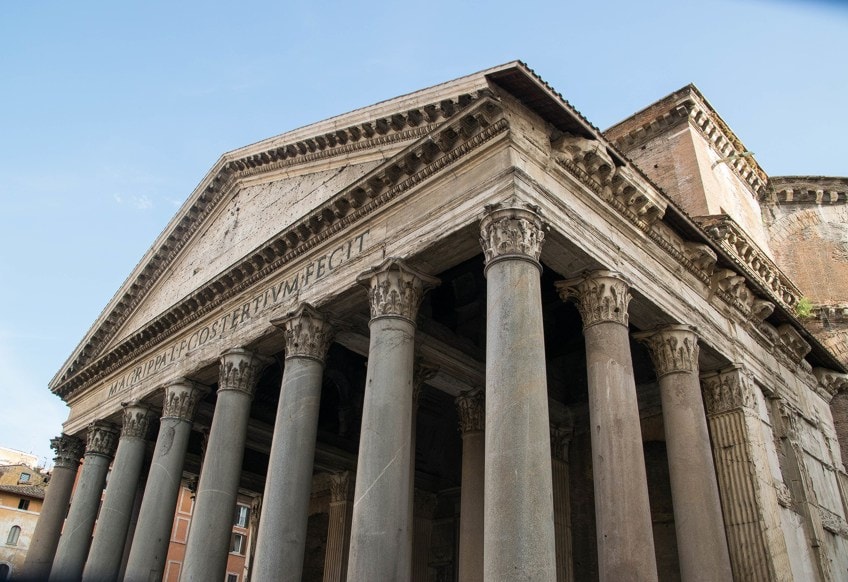
The Rotunda
The main structure of the building, which holds everything together, is referred to as the rotunda, which is Italian for “round”. The rotunda was the first element of the Pantheon to be built while making use of the Roman concrete system. When entering the Pantheon, your eye is immediately drawn upward to a magnificent, coffered dome ceiling that is made entirely out of a single piece of concrete with a round skylight in the middle which fills the entire atrium with natural light.
The skylight is called the oculus, which is “the eye” in Latin.
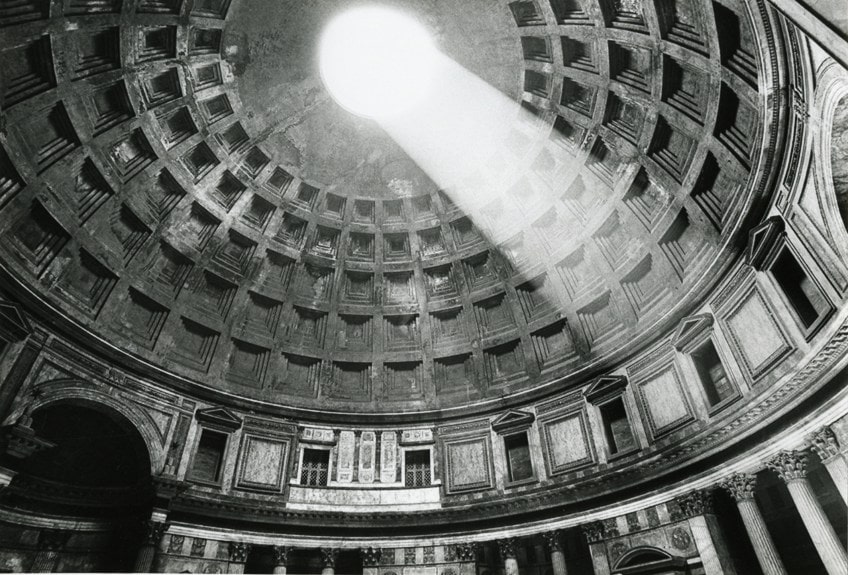
The oculus is not covered by any type of glazing, which makes the Pantheon exposed to weather conditions like rain. As many as 22 small drainage holes were made in the convex floor in the event that rain enters the Pantheon. The floor is made from original colored marble slabs with maroon, mustard, and gray geometric shapes.
These marble slabs were imported from all over the Mediterranean and symbolize the wealth and power of the Roman empire.
The style of the interior walls and decoration differs entirely from the dome that was placed upon it. The heavily ornamented, colorful marble walls are so in contrast to the geometrical perfect and cold sphere dome, that it almost looks as if the dome is an entity of its own entirely – almost giving the sense that the dome should be able to rotate.
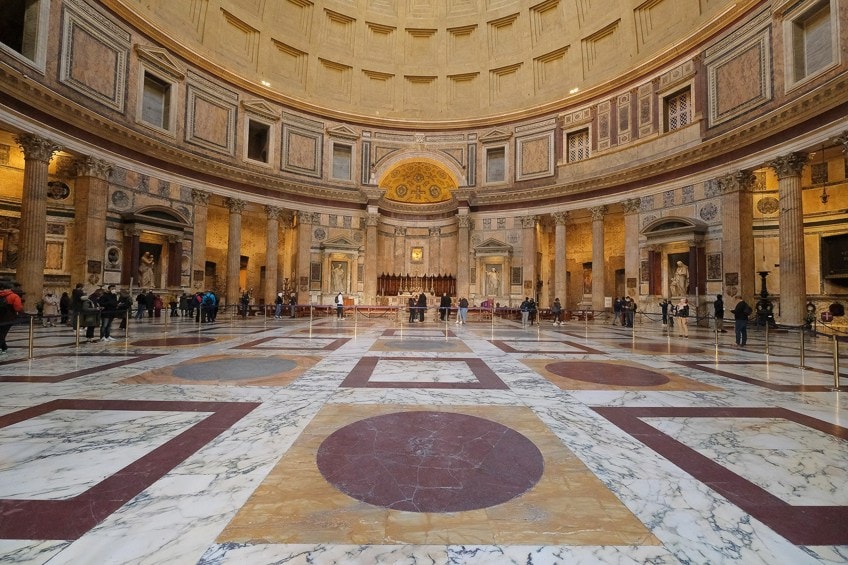
Others see this as a symbol of the earthly sphere meeting with the heavenly sphere. This theory is also supported when the movement of light through the oculus is taken into consideration, almost like a movement of the heavens. The sunlight reflects a circle on the sides of the dome and rotunda and rotates throughout the entire day, functioning almost like a sundial. The walls of the rotunda encompass seven life-size niches that are framed by two Corinthian columns each.
These niches originally housed the seven gods, who were associated with the worship of planets. These gods were: Mars, Mercury, Jupiter, Saturn, Venus, the Moon, and of course, the Sun.
With the transition of the Pantheon to Christianity, these sculptures were removed, and the niches are now used as small altars that are dedicated to Christian martyrs. The following are some of the murals and statues that can be seen in the Pantheon today:
- Fresco of The Annunciation (15th century) for Antoniazzo Romano, by Melozzo da Forli
- Two 17th-century angel statues, most likely by Gian Lorenzo Bernini
- 14th-century fresco of The Coronation of the Virgin by Diego Velázquez
- The Virgin and Child statue from the seventh century by an unknown artist
The Pantheon is one of the first historic buildings that favored the interior over the exterior, which is why it is so adored by, not only architects but interior designers alike and used as a reference for many other exceptional buildings.

The Dome
The diameter of the Pantheon is 143 feet wide and the height from the floor to the top of the dome is also 143 feet high, which makes the Pantheon interior a perfect sphere with outstanding mathematical proportions. These dimensions also make the Pantheon the title holder of the largest unreinforced dome, made from concrete in the world. The large construction was made possible by making the rims of the dome as thick as 23 feet, out of heavy rocks.
Nearing the oculus, the dome becomes thinner and thinner, reaching about 43 feet, and is made from mostly light pumice.
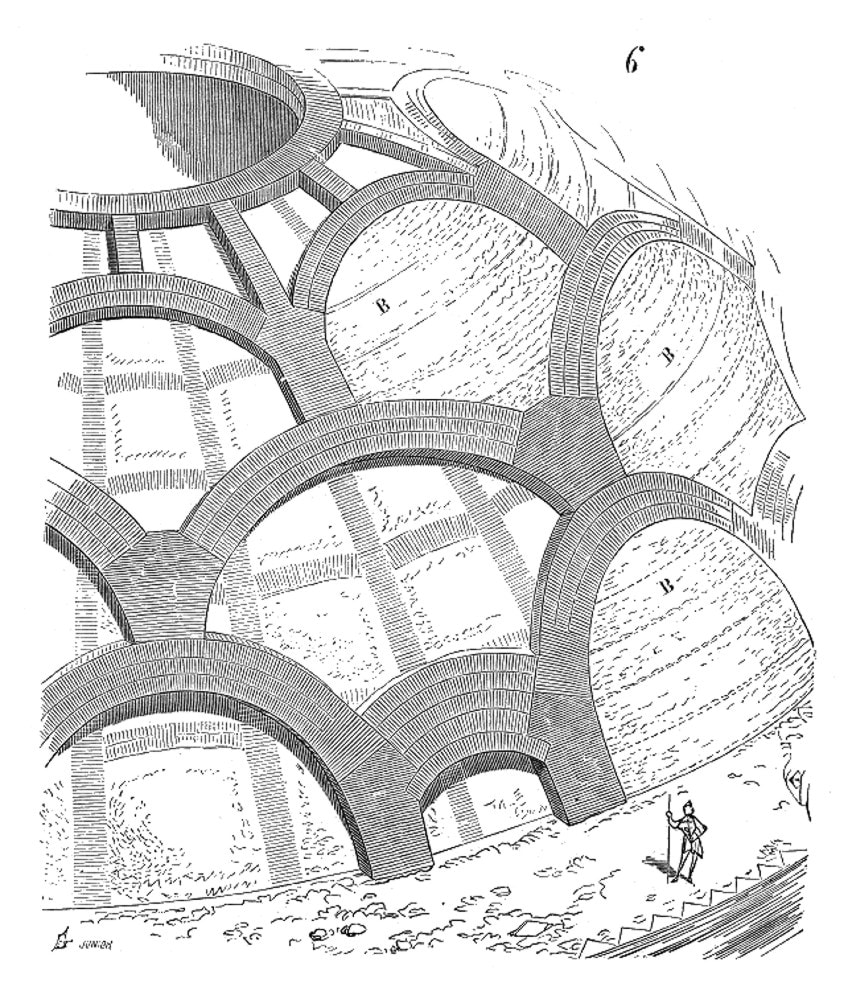
Originally, the dome was clad in bronze before it was melted down under the ruling of pope Urban VIII, and it is speculated that the bronze was used by Bernini to construct the baldachin that sits above Peter’s grave in St. Peter’s Basilica.
Other historians think that this statement is false because Bernini did not trust the characteristics of the alloy.
The rounded ceiling comprises five rings of 28 rectangular coffers. Although they serve an aesthetically pleasing decorative purpose, these coffers are very functional to the construction of the dome: hollowing out these coffers decreased the weight of the overall concrete dome structure by 550,000 pounds.
The Oculus
The diameter of the oculus is 28.5 feet and is the only source of light that fills the Pantheon, aside from the entryway. At first glance, it is assumed that the oculus was constructed for the practical purpose of lighting up the interior of the Pantheon, which is true, but it is speculated that the goal of the construction of the oculus was also to bring the dweller in direct contact with the heavens and the gods. The oculus served varying purposes during the time of the Roman Empire:
- Being the only light source in the dome, it fills the interior with natural light throughout the day.
- It lightened the weight of the entirety of the concrete dome structure.
- It served as a large-scale sundial, where the sunray indicated the passage of each hour through its positioning throughout the dome and the rotunda. There is also a theory that the Pantheon’s doorway is illuminated by the sun during Rome’s birthday every year, which is the 21st of April.
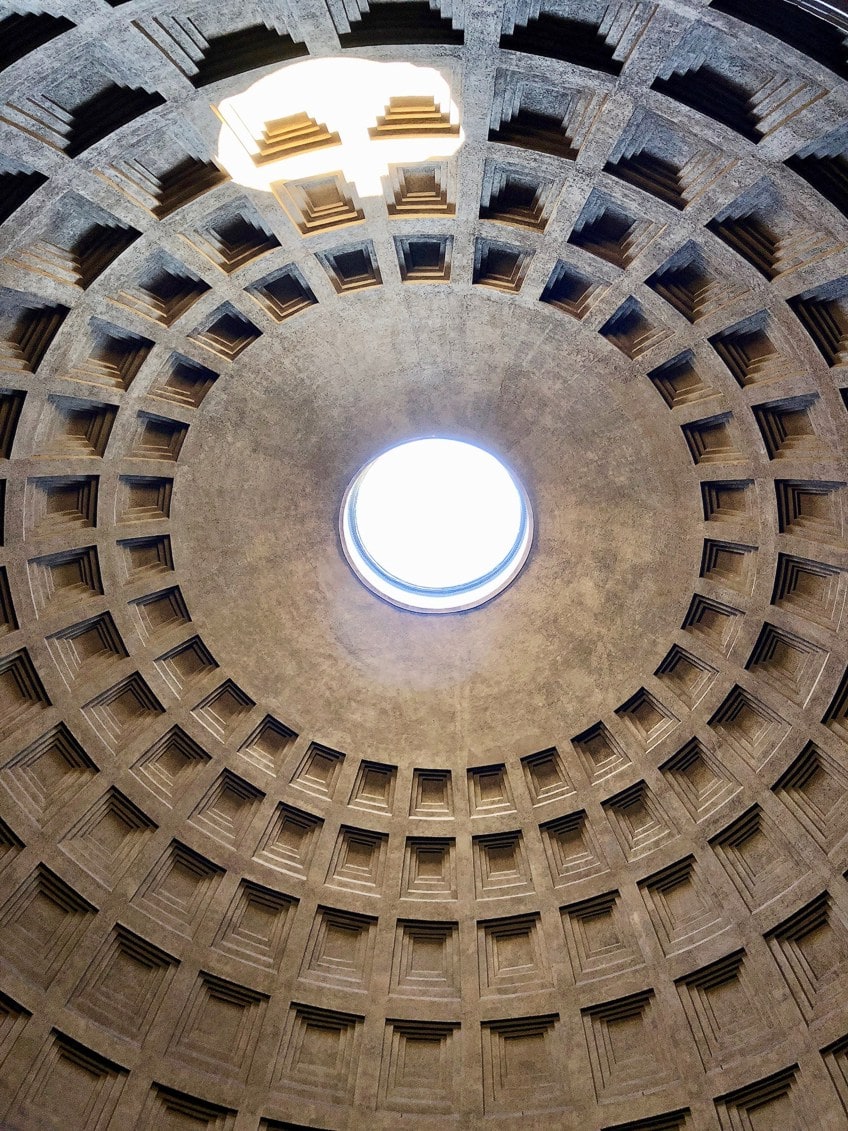
- Rumors during the Middle Ages stated that the hole was created during the conversion of the Pantheon to a church. The legend goes that when the building was converted, the pagan demons who inhabited the structure were forced to flee, smashing a hole through the dome as they desperately tried to escape the newly named Christian house of God.
- Romans believed that there should never be a roof on a Roman temple, which an opening in the roof structure accommodated for in the form of the Oculus.
Looking closely at the oculus, it is evident that there is a bronze molding around it, which happens to be the only surviving element from the original Pantheon roof that was gilded in bronze. It was replaced with led sheeting that still covers the dome today.
The Influence of the Pantheon of Rome
A significant historic building that is so well preserved, and open for all to study, makes it a perfect source of inspiration for many creatives. As humans, it is our nature to take inspiration from the existing and to build on it and make it better. Architects and artists all over the world have been influenced by this historic building.

Pantheon Architecture’s Influence on Modern and Renaissance Architecture
Throughout the centuries the Pantheon of Rome or certain elements of the pantheon has been replicated in many other famous modern buildings. The most evident influence of the pantheon is, of course, on architecture.
| Building | Architect | Date |
| National Gallery of Art | John Russel Pope | 1941 |
| St. Peter’s Basilica | Michelangelo, Donato Bramante, Gian Lorenzo Bernini, and Carlo Maderno | 1506 |
| Low Memorial Library | Charles Follen McKim of McKim, Mead & White | 1895 |
| Palladio, La Rotunda, Vicenza, Italy | Andrea Palladio | Begun 1550 |
| Rotunda, University of Virginia | Thomas Jefferson | Begun 1822 |
| Monticello, Virginia | 1772 | |
| Solomon R. Guggenheim Museum, New York City | Frank Lloyd Wright | 1942-1959 |
The Pantheon of Rome and Art
Many artists were bound to have been influenced by the Pantheon at some point. If even the loved Raphael was so inspired by the Pantheon, how could any artist not be? One specific painting comes to mind when referring to the pantheon: Interior of the Pantheon, Rome (1747) by Giovanni Paolo Panini.
The Interior of the Pantheon, Rome, is exactly what the title states: A painting of the interior of the pantheon. Panini made sure to fill the painting with numerous foreign visitors. Looking closely at the visitors, it is evident that they are from all parts of society and include both locals and foreigners.
He painted some of them as admiring the architecture of the pantheon, and others as making use of the space as a place of worship.
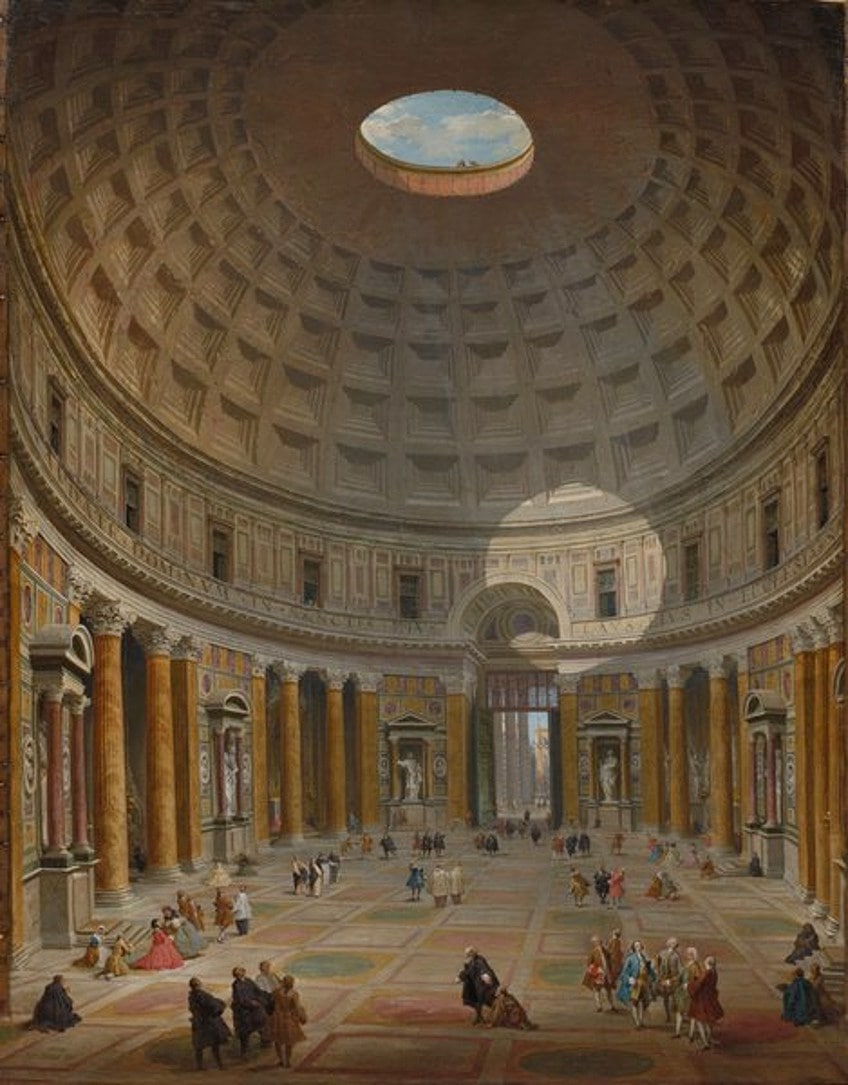
What makes this painting so unique in comparison to other paintings of the pantheon, is that Panini exaggerated the viewpoint of the painting, extending it far beyond what a person would ever be able to see in a photograph, even. All of the significant aspects of the interior of the pantheon are visible in this painting: from the large bronze doors to the oculus in the dome, flooding the interior with natural lighting.
Although we may never officially know the true circumstances surrounding the origins of the Pantheon in Rome, the existence of this spectacular building spiritually inspires all of its viewers, no matter their occupation, race, or religion. The Pantheon is sure to remain an inspiration to all for years still to come and is the one building that should be on everyone’s bucket list.
Take a look at our Roman Pantheon webstory here!
Frequently Asked Questions
What Is the Pantheon?
The Pantheon is a temple that was built during the reign of the Roman empire and was dedicated to the Roman Gods. Today, the Pantheon serves as a Christian Place of Worship, which played a large role in why the Pantheon is so well preserved to this day.
What Is a Pantheon?
What is a pantheon? For being such a popular building, not many people know the answer to this question. The word Pantheon is used when referring to a group of people of importance, particularly gods or a group of people of a particular religion. Pan means all, and theos means gods.
When Was the Pantheon Built?
When was the Pantheon built? The answer to this can be a bit complicated as it depends whether the original pantheon is being referred to, or the Pantheon that exists today. The structure that exists today was completed around 126 to 128 AD, during the rise of the Roman Empire.
When Was the Original Pantheon Built?
The original Pantheon was located in the Campus Martius and built by Marcus Agrippa in 27 AD.
What Was the Pantheon Used for Originally?
What was the pantheon used for? There is no concrete answer to this question. However, when referencing the meaning of the word Pantheon, it is safe to assume that the Pantheon was originally used as a place to worship the Roman Gods, and it was also a place where important meetings were held by the Roman emperors.
What Is the Pantheon Used for Currently?
Today, the Pantheon functions as a church that attracts tourists from all over the world. Catholic mass is held in the Pantheon on a regular basis.
Who Built the Pantheon?
So, who built the Pantheon exactly? When answering this question, it is important to consider whether the original Pantheon or the current Pantheon is being referred to. The original Pantheon was built by Marcus Agrippa. A fire completely destroyed the original building, after which Domitian had it restored in 80 AD. Eight years later, Hadrian became Emperor and started a building program that included the rebuilding of the Pantheon to how we see it today.
What Was the Pantheon Made Of?
What was the Pantheon made of? This is one of the first questions that will come to mind when engineers or architects look at the Pantheon because of its sheer amount of volume alone. The Pantheon was made primarily from Roman concrete and bricks. The walls of the Pantheon were made entirely from Roman concrete, which was made from volcanic ash, known as Pozzolana, which was mixed with lime and fresh water. The first step was to create a form for the concrete, which in those days was made from bricks. Coarse aggregate made from limestone pieces and broken tiles was layered down first, after which a combination of lime and pozzolana was troweled over it.
Why Is the Pantheon So Well Preserved?
Unlike most Roman temples, the Pantheon is one of the most well-preserved temples and the reason for this is that it was converted into a church after the fall of the roman empire
What Happens in the Pantheon on the 21st of April?
The 21st of April is considered a special day each year for the Pantheon, because at midday the light that streams through the oculus shines on the metal grill above the large entrance door, which causes light to reflect throughout the entire courtyard, illuminating the whole interior of the Pantheon. What makes this date all the more significant is the fact that the 21st of April is considered the anniversary of the day that Rome was founded. It is also rumored that on the day when Rome was founded, the ruling emperor had a god-like illumination surrounding him, which was the result of the rare reflection of light throughout the Pantheon.
Kylie Deyzel is an interior designer and sustainability enthusiast from Cape Town, South Africa. She has a passion for writing and educating others on various interior design topics. Her favorite interior design topics include interior design theory, interior design history, and most of all: sustainable interior design.
She received her B-tech degree in interior design from the University of Johannesburg in 2018 and has worked at various interior design firms since and had a few of her own freelance interior design clients under her company name binnekant.
Learn more about the Art in Context Team.
Cite this Article
Kylie, Deyzel, “Pantheon Rome – A Look at the Roman Pantheon’s Architecture.” Art in Context. August 23, 2022. URL: https://artincontext.org/pantheon-rome/
Deyzel, K. (2022, 23 August). Pantheon Rome – A Look at the Roman Pantheon’s Architecture. Art in Context. https://artincontext.org/pantheon-rome/
Deyzel, Kylie. “Pantheon Rome – A Look at the Roman Pantheon’s Architecture.” Art in Context, August 23, 2022. https://artincontext.org/pantheon-rome/.


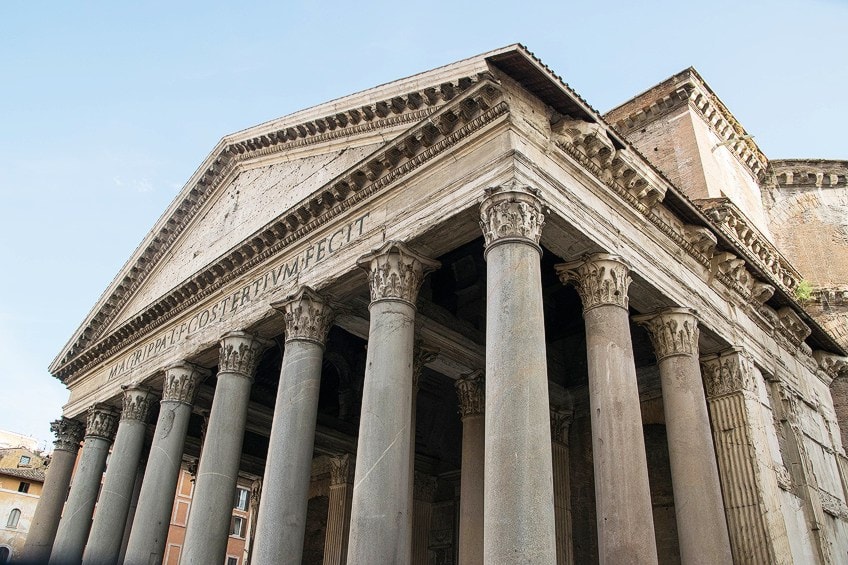


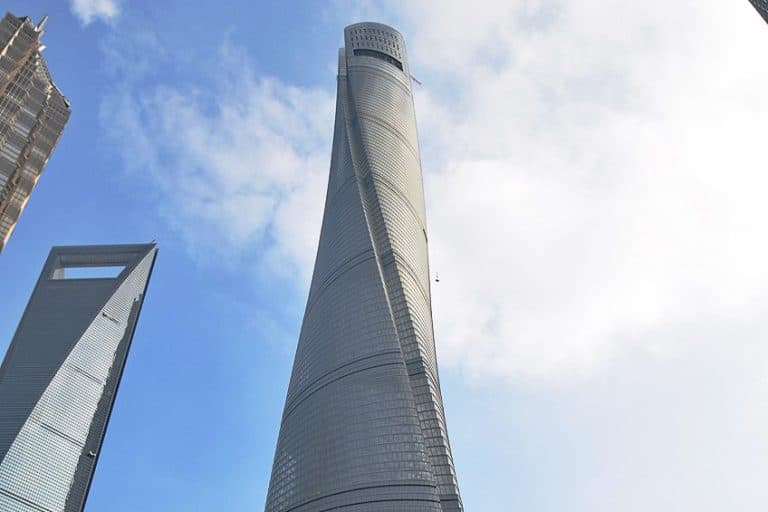

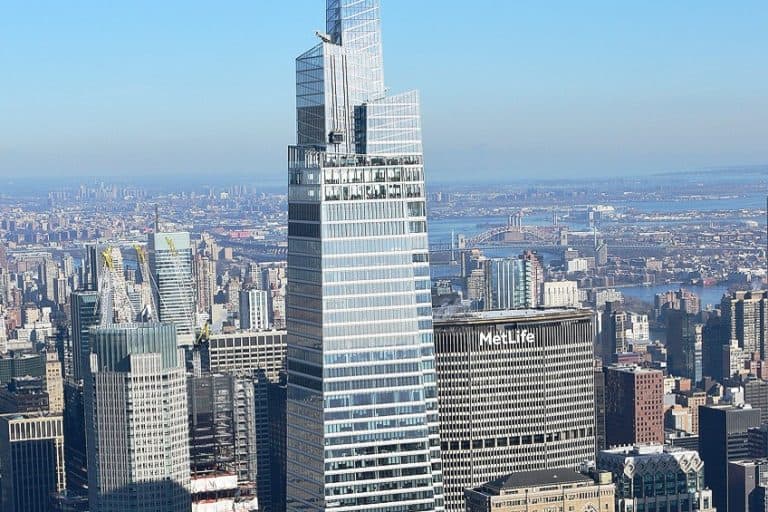


Good article, just letting you know you have a typo regarding Trajan’s death date, obviously you meant 117 A.D. but have 177 instead. Thx.
Thank you very much for your feedback and letting uns know about the typo, it has been fixed.